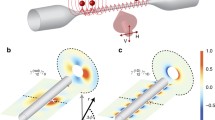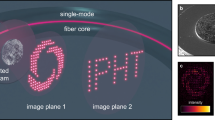Abstract
Radiation of an electric dipole (quantum emitter) in vicinity of optical structures still attracts great interest due to emerging of novel application and technological advances. Here we review our recent work on guided and radiation modes of electric dipole and optical fiber system and its applications from single photon source to metadevices. We demonstrate that the relative position and orientation of the dipole and the core diameter of the optical fiber are the two key defining factors of the coupled system application. We demonstrate that such a coupled system has a vast span of applications in nanophotonics; a single photon source, a high-quality factor sensor and the building block of metadevices.
Similar content being viewed by others
References
Vahala K J. Optical microcavities. Nature, 2003, 424(6950): 839–846
Afshar V S, Henderson M R, Greentree A D, Gibson B C, Monro T. MSelf-formed cavity quantum electrodynamics in coupled dipole cylindrical-waveguide systems. Optics Express, 2014, 22(9): 11301–11311
Hall J M M, Reynolds T, Henderson M R, Riesen N, Monro T M, Afshar S. Unified theory of whispering gallery multilayer microspheres with single dipole or active layer sources. Optics Express, 2017, 25(6): 6192–6214
Chew H, McNulty P J, Kerker M. Model for Raman and fluorescent scattering by molecules embedded in small particles. Physical Review A, 1976, 13(1): 396–404
Arnold S, Khoshsima M, Teraoka I, Holler S, Vollmer F. Shift of whispering-gallery modes in microspheres by protein adsorption. Optics Letters, 2003, 28(4): 272–274
Quan H, Guo Z. Simulation of whispering-gallery-mode resonance shifts for optical miniature biosensors. Journal of Quantitative Spectroscopy & Radiative Transfer, 2005, 93(1–3): 231–243
Guo Z, Quan H, Pau S. Near-field gap effects on small microcavity whispering-gallery mode resonators. Journal of Physics D, Applied Physics, 2006, 39(24): 5133–5136
Imakita K, Shibata H, Fujii M, Hayashi S. Numerical analysis on the feasibility of a multi-layered dielectric sphere as a three-dimensional photonic crystal. Optics Express, 2013, 21(9): 10651–10658
Li M, Wu X, Liu L, Xu L. Kerr parametric oscillations and frequency comb generation from dispersion compensated silica micro-bubble resonators. Optics Express, 2013, 21(14): 16908–16913
Farnesi D, Barucci A, Righini G C, Conti G N, Soria S. Generation of hyper-parametric oscillations in silica microbubbles. Optics Letters, 2015, 40(19): 4508–4511
Ruan Z, Fan S. Superscattering of light from subwavelength nanostructures. Physical Review Letters, 2010, 105(1): 013901
Agio M. Optical antennas as nanoscale resonators. Nanoscale, 2012, 4(3): 692–706
Novotny L, van Hulst N. Antennas for light. Nature Photonics, 2011, 5(2): 83–90
Bharadwaj P, Deutsch B, Novotny L. Optical antennas. Advances in Optics and Photonics, 2009, 1(3): 438–483
Kivshar Y, Miroshnichenko A. Meta-optics with Mie resonances. Optics and Photonics News, 2017, 28(1): 24–31
Zheludev N I, Kivshar Y S. From metamaterials to metadevices. Nature Materials, 2012, 11(11): 917–924
Snyder A W, Love J. Optical Waveguide Theory. 1st ed. London: Chapman and Hall Ltd, 1983
Henderson M R, Afshar V. S, Greentree A D, Monro T M. Dipole emitters in fiber: interface effects, collection efficiency and optimization. Optics Express, 2011, 19(17): 16182–16194
Henderson M R, Gibson B C, Ebendorff-Heidepriem H, Kuan K, Afshar V S, Orwa J O, Aharonovich I, Tomljenovic-Hanic S, Greentree A D, Prawer S, Monro T M. Diamond in tellurite glass: a new medium for quantum information. Advanced Materials, 2011, 23(25): 2806–2810
Ebendorff-Heidepriem H, Ruan Y, Ji H, Greentree A D, Gibson B C, Monro T M. Nanodiamond in tellurite glass Part I: origin of loss in nanodiamond-doped glass. Optical Materials Express, 2014, 4 (12): 2608–2620
Ruan Y, Ji H, Johnson B C, Ohshima T, Greentree A D, Gibson B C, Monro T M, Ebendorff-Heidepriem H. Nanodiamond in tellurite glass Part II: practical nanodiamond-doped fibers. Optical Materials Express, 2015, 5(1): 73–87
Atakaramians S, Miroshnichenko A E, Shadrivov I V, Mirzaei A, Monro T M. Kivshar Y S, Afshar V S. Strong magnetic response of optical nanofibers. ACS Photonics, 2016, 3(6): 972–978
Atakaramians S, Miroshnichenko A E, Shadrivov I V, Monro T M. Kivshar Y S, Afshar V. S. Dipole-fiber systems: radiation field patterns, effective magnetic dipoles, and induced cavity modes. In: Proceedings of SPIE 9668, Micro + Nano Materials, Devices, and Systems, 2015, 96683J
Fussell D P, McPhedran R C, Martijn de Sterke C. Decay rate and level shift in a circular dielectric waveguide. Physical Review A, 2005, 71(1): 013815
Jackson J. Classical Electrodynamics. 3rd ed. New York: John Wiley & Sons, Inc., 1998
Grahn P, Shevchenko A, Kaivola M. Electromagnetic multipole theory for optical nanomaterials. New Journal of Physics, 2012, 14 (9): 093033
Acknowledgements
S. Atakaramians acknowledges the support of Australian Research Council (ARC) under the Discovery Early Career Project Award number DE140100614. T. M. Monro acknowledges the support of ARC Georgina Sweet Laureate Fellowship.
Author information
Authors and Affiliations
Corresponding author
Additional information
Dr. Shaghik Atakaramians is a Scientia Fellow at the Unieristy of New SouthWales (UNSW), Syndey. She joined the School of Electrical Engineering and Telecommunicates at UNSW in June 2017 and leads terahertz activities within the School.
Shaghik Atakaramians was awarded ARC Discovery Early Career Researcher Award (DECRA) in 2014 on terahertz metamaterial waveguides. She worked at the Institute of Photonics and Optical Science (IPOS) at the University of Sydney from 2011 to 2017 as a postdoctoral and research fellow. She also worked for The Centre for Ultrahigh bandwidth Devices for Optical Systems (CUDOS) from 2012 to 2014.
Shaghik Atakaramians received her Ph.D. degree in Electrical & Electronic Engineering with a Certificate of Merit from the Dean in 2011. Her PhD thesis has won the Gertrude Rohan Memorial Prize and 2011 University Doctoral Research Medal for outstanding research.
Prof. Tanya M. Monro took up the role of Deputy Vice Chancellor Research and Innovation in November 2014.
The ARC Georgina Sweet Laureate Fellow at the University of South Australia, Prof. Monro was the inaugural Director of the Institute for Photonics and Advanced Sensing (IPAS) from 2008 to 2014 and was also the inaugural Director for the ARC Centre of Excellence for Nanoscale BioPhotonics (CNBP) at the University of Adelaide. Her research is in the field of photonics, with a focus on sensing, lasers and new classes of optical fibres.
Prof. Monro obtained her Ph.D. degree in Physics in 1998 from The University of Sydney, for which she was awarded the Bragg Gold Medal. In 2000, she received a Royal Society University Research Fellowship at the Optoelectronics Research Centre at the University of Southampton.
Prof. Monro is a Fellow of the Australian Academy of Science (AAS), the Australian Academy of Technological Sciences and Engineering (ATSE), the Optical Society of America (OSA) and the Australian Institute of Physics. She is a member of the Prime Minister’s Commonwealth Science Council (CSC), and a Board Member of the Commonwealth Science and Industrial Research Organisation (CSIRO), the South Australian Defence Advisory Board, and the South Australian Economic Development Board.
Tanya’s awards include: Eureka Prize for Excellence in Interdisciplinary Scientific Research, the Bragg Gold Medal (best Physics PhD in Australia), South Australia’s “Australian of the Year”, Scopus Young Researcher of the Year, South Australian Scientist of the Year, and the Prime Minister’s Malcolm McIntosh Prize for Physical Scientist of the Year.
A/Prof. Shahraam AfsharV. received his Ph.D. degree in Physics, Laser and Nonlinear Optics, from the University of Adelaide in 2001. From 1998 to 2001, he held a lecturer position at The University of Adelaide.
In 2001, he joined the fibre optics group at The University of Ottawa, where he worked on distributed strain and temperature sensors based on Brillouin scattering in optical fibers. In 2003, he received the NCIT fellowship from National Capital Institute of Telecommunication, Canada to work on Brillouin scattering in photonic crystal fibres.
In 2005, he joined the Centre of Expertise in Photonics (CoEP) at the University of Adelaide, which later on formed into the Institute for Photonics and Advanced Sensing (IPAS). Since 2015, he is an Associate Professor of Photonics at School of Engineering of University of South Australia. His research interests cover different linear and nonlinear processes in optical waveguides including fiber optic sensors, nonlinear fibre optics, and strong light-matter interactions in subwavelength fibers.
Rights and permissions
About this article
Cite this article
Atakaramians, S., Monro, T.M. & Afshar V., S. Dipole-fiber system: from single photon source to metadevices. Front. Optoelectron. 11, 30–36 (2018). https://doi.org/10.1007/s12200-018-0762-8
Received:
Accepted:
Published:
Issue Date:
DOI: https://doi.org/10.1007/s12200-018-0762-8




